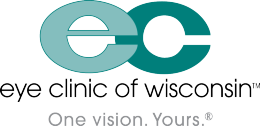5 Things Physicians and Patients Should Question
Posted by ecwadmin on September 30, 2013 in Health.
5 Things Physicians and Patients Should Question comes from the American Academy of Ophthalmology with reaction from Kevin Flaherty M.D., ophthalmologist with the Eye Clinic of Wisconsin:
1. Don’t perform preoperative medical tests for eye surgery unless there are specific medical indications.
Dr. Flaherty’s comments: Most eye surgeries are done under topical or local anesthesia rather than general anesthesia (so the patient is awake but the eye is numb). The vast majority of eye surgeries are not long and do not pose serious risks. If a patient is a diabetic, then their blood sugar should be known before surgery. If patients are taking water pills for high blood pressure, then a potassium test may be ordered. If patients have heart disease and the surgery may involve IV sedation or the patient being put to sleep for surgery, then an EKG should be ordered.
2. Don’t routinely order imaging tests for patients without symptoms or signs of significant eye disease.
Dr. Flaherty’s comments: In the absence of signs or symptoms of significant eye pathology, then imaging tests such as visual field tests, optical coherence tomography (OCT) testing, retinal photos of patients with diabetes, or other ultrasound or radiology tests are generally not needed. A detailed clinical history and comprehensive eye exam by an ophthalmologist will almost always reveal if eye disease is present or is worsening. If symptoms or signs of disease are present, then imaging tests may be needed to further evaluate and help guide treatment or assess response to treatment.
3. Don’t order antibiotics for adenoviral conjunctivitis (pink eye).
Dr. Flaherty’s comments: “Pink eye” can be a sign of various conditions. Conjunctivitis can be viral, bacterial or allergic. Antibiotics should only be used for bacterial conjunctivitis. An ophthalmologist can differentiate these causes by a careful history, external clinical and slit lamp exam, and cultures if needed. Antibiotics are indicated for patients with bacterial conjunctivitis; however, they have no benefit in patients with viral or allergic conjunctivitis. The overuse of antibiotics can lead to more bacteria becoming resistant to antibiotics, thus, making treatment more difficult when antibiotics are truly needed.
4. Don’t routinely provide antibiotics before or after intravitreal injections.
Dr. Flaherty’s comments: With many patients now receiving intravitreal injections for conditions such as “wet” macular degeneration, or for retinal swelling or bleeding associated with other diseases, there is always a small risk for infection inside the eye. Research, however, has now shown that topical antibiotics do not eliminate the risk of infections. The use of antibiotics also carries the risk of allergic reactions, and overuse of antibiotics can lead to the emergence of bacteria that are resistant to available treatments. It is much more appropriate to do a thorough prep with an iodine/antiseptic solution and use sterile techniques to prevent eye infections associated with injections.
5. Don’t place punctal plugs for mild dry eye before trying other medical treatments.
Dr. Flaherty’s comments: While punctal plugs are a safe and effective method to help treat dry eyes, it is more appropriate to first try medical treatments like artificial tears, lubricating ointments, treating concurrent lid margin disease with warm soaks and lid hygiene before placing punctal plugs. The local environment can also be modified by increasing the humidity, closing the eyes more often, or even wearing glasses or goggles to decrease evaporation of the tears. There are also prescription medications that can increase tear production, however, these are expensive. If the patient’s tear film and eyelids have been treated and the dry eye symptoms persist, then punctal plugs can be placed to help the patient conserve their own tears and usually provide additional relief.









